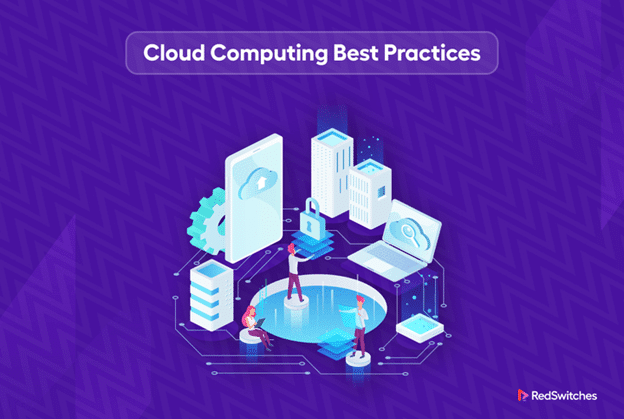Cloud computing is a rapidly emerging technology that has changed how we store, process, and manage data.
Thanks to rapidly emerging cloud technologies, businesses and individuals can access vast computing resources over the Internet without investing in expensive hardware and software infrastructure.
As a result, businesses have become more agile, responsive and discovered new opportunities for innovation and growth. Recent studies have shown that approximately 94% of enterprises use cloud services.
This article will explore what is cloud computing and its many benefits that can lead to improved business operations and, eventually, growth. We’ll start with definitions and then discuss cloud architecture, security, and deployment models.
Let’s start with the basics of cloud computing operations.
How Does Cloud Computing Work?
Cloud computing leverages the internet to provide various services and hardware virtualization of servers and storage devices.
The technology eliminates the burden of acquiring and maintaining an in-house infrastructure. As a result, businesses experience more efficient operations and reduced operational costs.
Additionally, it allows businesses to scale up and quickly adapt to market changes.
With the advent of cloud computing, the need for on-premises data storage has diminished. “Cloud storage” implies that data can be stored virtually and accessed anywhere. This eliminates the need for in-house server banks, as data processing is done through remote server clusters. Cloud computing enables you to perform tasks without being tied to a physical location.
What Are the Different Types of Cloud Computing Services?
Now that you understand what cloud computing is and how it works, let’s discuss its different types. Cloud computing services have significantly matured in the last decade. These services now form the core of ICT services businesses and end users use worldwide. If you’re considering these services for improving your business processes, you should know the primary cloud computing services you can opt for.
Infrastructure as a Service (IaaS)
In the 2010s, Infrastructure as a Service (IaaS) was the most widely adopted model. IaaS provides pay-per-use access to essential computing resources, such as networking, storage, and physical & virtual servers.
With IaaS, businesses can fine-tune their resource allocation and ensure an optimized website and app platform. In addition, since managed bare-metal-based IaaS services can be easily scaled, there’s no need for significant upfront investments.
Software as a Service (SaaS)
Software as a Service (SaaS), or cloud-based software or cloud apps, refers to application software hosted in the cloud that can be accessed through a web browser, desktop client, or an API.
You’ll find that SaaS is rapidly displacing traditional software in all areas. A vital characteristic of this rise of SaaS is the transition to a subscription payment model where users pay a small amount for regular access to the software platform. As such, SaaS offers several benefits, including automatic upgrades, data loss protection, cost savings, customizable user experience, and scalability.
Platform as a Service (PaaS)
With Platform as a Service (PaaS), software developers can access an on-demand platform that includes hardware, a complete software stack, middleware infrastructure, and development tools. The cloud provider manages everything from their data center and delivers a full-featured development and maintenance environment. This enables developers to operate, build, and manage applications with ease.
Serverless Computing
Serverless computing refers to a cloud computing execution model where the cloud provider manages the infrastructure and automatically allocates resources as needed to run the code. In this model, the user does not have to provision, manage, or scale servers, as the cloud provider handles all these tasks. Instead, the user only needs to upload their code and specify the triggers (such as a user action or an API request) for executing the code.
With serverless computing, users pay only for the exact volume of resources used to run their code. This makes it a cost-effective option, as users only pay for the compute time they consume rather than a pre-allocated resource volume.
Additionally, serverless computing enables rapid scalability as the cloud provider automatically allocates resources as needed. Therefore, the user’s code can handle traffic spikes without manual intervention.
What Are the Different Cloud Computing Models?
Now that you know about cloud computing services and the various options available for incorporating them into your business processes, it is time to go into the details of how these services are delivered to businesses. Apart from what is cloud computing, this is another commonly asked question.
Public Cloud
A public cloud is a cloud computing model where a service provider provides users with various resources (including virtual machines (VMs) and bare metal computing hardware) through a public network. The infrastructure in the cloud provider’s data center is shared among all public cloud users, creating a multi-tenant environment.
Private Cloud
A private cloud is a computing environment where a single customer has exclusive access to all infrastructure and computing resources. This model combines the security and access control of on-premises infrastructure with the benefits of cloud computing, such as scalability, elasticity, and ease of service delivery. A private cloud provides the customer with a high level of customization and control over their computing resources.
Community Cloud
Cloud architecture enables multiple organizations to share resources and services based on established operating and legal standards. Businesses with similar requirements can become members of a community cloud, often composed of businesses in the same industry or divisions of the same company. The community cloud is a cohesive system that blends the features and benefits of various cloud models to meet the specific needs of a particular sector.
Hybrid Cloud
A hybrid cloud is a combination of both private and public cloud environments. This model combines organizational resources, offering private and public resources. This allows a company to choose the most suitable cloud for a particular scenario and quickly move workloads between the two clouds as the situation demands.
The hybrid cloud provides the benefits of both private and public clouds, resulting in a more adaptable cloud computing solution.
Benefits of Cloud Computing
Cloud computing services are spreading across the globe quite quickly. More and more businesses are beginning to invest in it, especially online businesses. If it’s spreading so quickly like wildfire, there must be something to it, no?
Cloud computing services offer a host of benefits to businesses, such as:
Cost-Effective Operations
One of the benefits of cloud computing is that it doesn’t burden your pocket. No matter what cloud service model you choose, you only pay for the resources you use. This reduces overspending on data center equipment and operations. Businesses can invest the freed-up resources in other critical business processes.
You also don’t have to worry about the cost of hardware upgrades if you need more resources, as you simply pay for the additional resources you use during a billing period. This flexible payment model allows you to maximize your return on investment and minimize overall business costs.
Improved Communication and Collaboration
With the help of cloud computing services, employees can access data remotely and are not limited to a specific location or device.
This opens up new possibilities for remote work and flexible schedules, making it easier for people to stay connected and be productive no matter where they are. Research indicated that 80% of businesses noticed operation improvements in the first few months after adopting cloud computing services.
Better Security and Encryption
Contrary to popular belief, cloud computing services offer various security features, regular maintenance, and centralized management that enhance a business’s overall security.
By utilizing cloud storage, you can rest assured that your data is secure, as cloud providers continuously improve their security systems to mitigate the risk of viruses, cyber-attacks, and other sources of data breaches.
Backup and Data Recovery Options
Compared to traditional on-premises data centers, cloud-based data storage solutions offer much better chances of recovering from incidents such as data loss and corruption.
Cloud storage solutions come with automated backup and recovery tools that ensure swift and smooth recovery of data stored at offsite locations.
Disadvantages Of Cloud Computing
Like all technology options, businesses should understand that cloud computing services are not a one-size-fits-all solution. Managers need to know the following points to make informed decisions about incorporating cloud computing services into their operations.
Limited Flexibility and Governance
In the case of public, hybrid, and community clouds, the cloud provider has complete control over all cloud computing services. However, customers are granted limited control and flexibility, with multiple restrictions on accessing various services and applications.
Businesses enter into separate end-user license agreements to gain control over the cloud’s services and applications.
Vendor Lock-in
Vendor lock-in occurs when a company using a particular vendor’s cloud computing services cannot switch to another provider because of high migration costs and dependency upon specific cloud services.
This leaves the business obligated to continue using the same provider, potentially affecting their workflow and efficiency. Switching to another vendor could result in technical difficulties, legal and regulatory barriers, and high data transfer costs.
Service Interruption and Downtime
Cloud computing services delivery depends solely on the internet. Any outages, either at the cloud provider’s or the internet connectivity, lead to service disruptions and increased downtime. This dependence on the internet is one of the most common criticisms of cloud computing.
What is Cloud Infrastructure?
Now that you understand everything there is about what is cloud computing, it’s time to look into cloud infrastructure. Cloud infrastructure refers to the hardware and computing server software components necessary for the effective functioning of cloud computing services.
Cloud infrastructure includes a hardware abstraction layer to maximize cost savings and provide resource virtualization. “cloud infrastructure” is also used interchangeably with other terms, such as utility and on-demand computing.
Organizations can save significant capital expenditures by utilizing cloud infrastructure, as they no longer need to invest in expensive hardware, data centers, and other physical facilities. Instead, they can focus on their core business activities, relying on cloud infrastructure to support their growing needs.
What is Cloud Architecture?
When understanding what is cloud computing, it’s also crucial to understand what is cloud computing architecture. Cloud computing architecture is divided into two parts, the front end, and the back end, which communicate via a network or the internet.
The front end comprises user-facing applications and interfaces, such as web browsers. On the other hand, the backend processes data collected at the front end through multiple VMs and data storage options.
This architecture is designed to tackle latency issues, increase data processing capabilities, lower IT operational costs, offer accessible data and digital resources, and make it easier for businesses to scale their cloud resources up or down.
Application Areas For Cloud Computing
Businesses use Cloud Computing services across a wide range of industries. The following list covers just the tip of the iceberg.
MarTech and AdTech
- Ad targeting and personalization.
- Analytical tools for marketing campaigns
- Improved customer data management
- Flexibility and scalability of marketing strategies
FinTech
- Secure data storage and processing
- Improved operational efficiency and compliance
- Integration of financial systems and data sources
- Real-time data analysis for informed decision-making
Healthcare
- Secure and centralized patient data management
- Real-time collaboration and information sharing among healthcare providers
- Efficient tracking of healthcare metrics and trends
- Improved telemedicine services and remote patient monitoring
ECommerce and Retail
- Improved customer experience through personalized recommendations and marketing
- Real-time inventory management and order fulfillment
- Better tracking of consumer behavior and purchasing habits
Software Development
- Access to a wide range of tools and resources
- Scalable infrastructure to accommodate growing development needs
- Improved collaboration and sharing among development teams
- Faster development and deployment of applications
Artificial Intelligence
- Access to high-performance computing resources
- Easy collaboration and sharing of data and models
- Cost-effectiveness and scalability in AI development and deployment
- Improved data security and privacy in AI projects.
Education
- Operational platforms for Massive Online Open Courses (MOOC)
- Easy delivery of HD-quality video and streaming solutions
- Distributed student management systems powered by virtualization
- Scalable bare-metal servers for hosting globally available educational services.
RedSwitches Facilitates Migration to Cloud Computing Services
RedSwitches provides dedicated servers and managed bare-metal servers that enable your business to take advantage of the advantages of cloud computing. These server solutions are further enhanced by services such as omnichannel support, same-day setup, on-demand customization, and more.
Focusing on security, scalability, and affordability, our solutions are designed to meet your evolving needs. Don’t miss out on the competitive advantage that cloud computing can bring to your business.
Switch to RedSwitches today and take the first step towards a more efficient and productive future.
Conclusion
We hope you now understand what is cloud computing and everything about it. Cloud computing has completely revolutionized how businesses operate and has become a crucial component of modern technology. With its numerous benefits, such as cost-effectiveness, scalability, and accessibility, it’s not surprising that businesses across various industries are adopting cloud computing.



